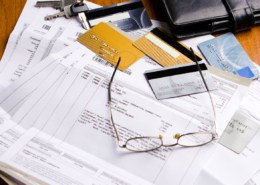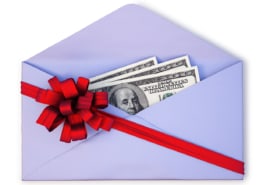Would You Rather Stick a Fork in Your Eye or Talk About Budgets?
For lots of people, just thinking the word “budget” is like nails on a chalkboard. I know the feeling. For many years I wouldn’t have anything to do with a budget because I couldn’t stand the idea of anyone—or anything—telling me how to spend my money. And where did that get me? Into one big financial mess. Every month, when we ran out of money, I would turn to MasterCard and Visa for a bailout. Really bad idea.
I learned from going through that experience and finding my way back to solvency that, as much as we loathe it, a budget is the ticket to financial happiness―not the straitjacket I feared it would be. I prefer to call this a “spending plan” rather than a budget, but the terms are interchangeable.
A good spending plan gives every dollar a specific job to do. Once you get things set up, the spending plan becomes an indispensable, handy road map for keeping your finances on track.
So, take a deep breath, and let’s walk through the basic principles of creating a simple budget, or spending plan.
Step 1
Write down your total take-home monthly income
This is the easy part. Jot down what you earn. Because many expenses are billed monthly, it makes good sense to use monthly net income—your take-home pay, all you have to spend each month after withholding—to create your budget.
Step 2
List your essential fixed expenses
Start with fixed bills like rent, mortgage, car payment, credit card debt, and insurance. Next, factor in other monthly costs that are always the same, items you must pay like subscriptions and contracts for things like a gym membersip. These are your essential fixed expenses.
Step 3
List your essential variable expenses
You know you’ll have these bills, but the amounts vary. Examples are your phone, utilities, food, household expenses, gasoline, medication, public transportation, shoes, and clothing. You can assign an estimated amount to each based on experience, rounding to the closest $10.
Step 4
List reasonable amounts for nonessential expenses
This includes entertainment, eating out, hobbies, and other ways you spend money on a regular basis.
Step 5
List irregular expenses
For items that do not recur monthly like car maintenance, Christmas, and vacation, determine the annual cost, then divide by 12 to see how much you should set aside each month to anticipate that irregular expense.
Step 6
Determine your totals
Add up all of your expenses for a single month, then subtract that amount from your net monthly income. With luck, you’ll come out in the black, with at least a little money left over. But you’ll see a negative sum if your expenses exceed your income. Don’t panic—this is just the start of an ongoing process.
Step 7
See where you can cut
If you came up short, go back to your monthly expenses and see what you can get rid of. Start with nonessentials. Think hard. Is that gym membership worth the expense, when you do have other free options for getting exercise. Keep going through the list, making adjustments until your total monthly expenses are less than your monthly net income.
Step 8
Follow your spending plan as closely as possible
Track your spending every day. Take notes and research ways you’ll be able to do even better next month. At month’s end, add up your actual spending and compare it with what you planned. Use this information to create the next month’s spending plan.
Congratulations—you’ve just elevated yourself from being clueless to some level of financially savvy. You should feel very good about this.
As difficult as it might be to see in black and white that your income and expenses are not quite in sync, just knowing where you are will make all the difference.
Take heart even if you find yourself in a particularly tight financial position right now. As you pay off debts and find more ways to cut expenses, you’ll begin to sense a significant loosening of financial pressure. Soon you’ll be ready to add new categories to your spending plan for things like saving for a new car, home improvements, or going back to college.
The sooner you get started, the sooner you’ll be on your way to reaching financial freedom.
Could you use some help?
I know that feeling, too. It’s a very long story, but bottom line: I wrote a book. It made it to the #2 spot on Amazon’s Best Seller list, which was exciting. It has sold a lot of copies. It’s still in print and its content is as true and reliable today as it was with that very first printing.
Debt-Proof Living is the long version of what you’ve just read above. I promise you that it is not boring, dry, or impossible to slog through. I know those kinds of books, this is not one of them.
Yes, I am biased and certainly prejudice because it’s my story—a journey from despair to financial freedom.
The last thing in the world I was thinking back in 1984 when my life fell apart and I was completely out of hope, “Hey, I’m going to get out of debt and then write a book about how I did it!” Uh no.
In fact, it was the most embarrassing, humiliating thing anyone could go through—why would I write about it? Besides I wasn’t a writer, not even much of a reader.
What happened and what we went through to get out of the mess was to be a secret I would take to my grave. And of course, that didn’t happen. I thank God for that.
Debt-Proof Living is the way I got out of debt—a huge unbelievable amount of debt—learned to manage money successfully, and now live and breathe to help others do the same.
Debt-Proof Living is a book, but it is also a method consisting of 5 elements, which I created many years ago, presented in an easy-to-read format. The method I came up with worked for my husband and me.
Over the years, thousands of people have used the debt-proof living method to get their finances in order and to get out of debt. I hear from them every day. It’s fantastic and it’s their stories and success that keeps me going.
I would consider it a joy and a privilege to walk with you on your journey to financial freedom.
Everyday Cheapskate participates in the Amazon Services LLC Associates Program, an affiliate advertising program designed to provide a means for us to earn from qualifying purchases, at no cost to you.
















I found the secret to saving is to put a consistent amount into savings every month (even if it’s only $5. Just be consistent and don’t get into your savings unless it is an actual emergency.
I love YNAB for budgeting (you need a budget).
Your book is well worth owning,I have read it in libraries in the 1990s and recently came across a copy in Goodwill,so it’s nice to have one now , it’s like having a financial bible, I looked today and had a book marker on Watch Your Attitude, that’s good advice when out there shopping and come across a good buy but dont really need it.it taught me to stop buying unnecessary things and to put the money in money making funds.Then the day came where it was much needed as in a Divorce and no job.So I would not be spending $300.00 on a LV Ladies hand bag, which seems popular now, that will hold no value in the future.I am Thankful for this Book
This title gave me a belly laugh this morning! I fall into the “FORK IN THE EYE, PLEASE!!” camp unfortunately. Keep gently prodding us, Mary!
The original Debt Proof Living changed my life years ago – it was the first time I actually understood how to budget correctly – and it was the freedom tool I needed. So grateful for you wisdom!
And I’m grateful for you, Cherie. Your feedback has encouraged me!